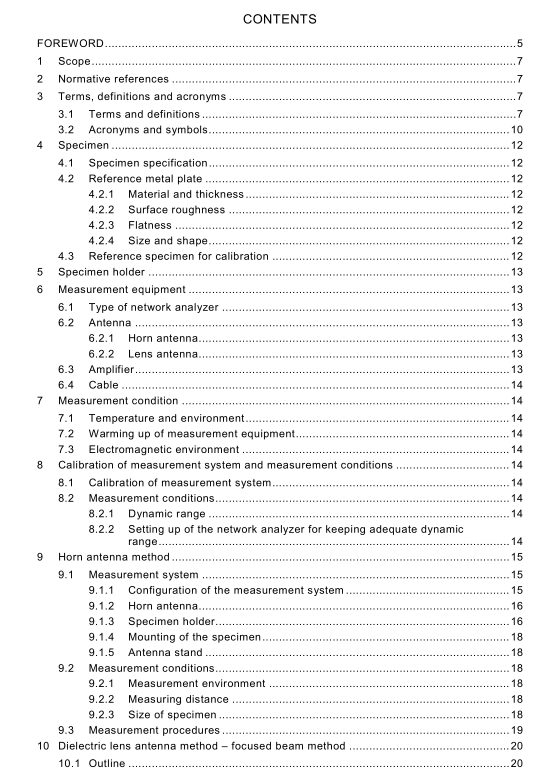IEC 62431 pdf – Reflectivity of electromagnetic wave absorbers in millimetre wave frequency – Measurement methods

IEC 62431 pdf – Reflectivity of electromagnetic wave absorbers in millimetre wave frequency – Measurement methods
This International Standard specifies the measurement methods for the reflectivity ofelectromagnetic wave absorbers (EMA) for the normal incident, oblique incident and eachpolarized wave in the millimetre-wave range. In addition,these methods are also equallyeffective for the reflectivity measurement of other materials:
measurement frequency range: 30 GHz to 300 GHz;reflectivity: 0 dB to -50 dB;
– incident angle: 0° to 80°.
NOTEThis standard is applicable not only to those EMA which are widely used as counter-measures againstcommunication faults, radio interference etc. , but also to those used in an anechoic chamber in some cases. EMASmay be any kind of material, and may have any arbitrary shape,configuration, or layered structure as pointed outbelow.
Material: Conductive material, dielectric material, magnetic material.Shape: planar-, pyramidal-, wedge-type, or other specific shapes.Layer structure: single layer,multi layers, or graded-index material.
2 Normative references
The following referenced documents are indispensable for the application of this document.For dated references, only the edition cited applies. For undated references, the latest editionof the referenced document (including any amendments) applies.
ISO/IEC 17025,General requirements for the competence of testing and calibrationlaboratories
3 Terms, definitions and acronyms
For the purposes of this document, the following terms and definitions apply.
3.1 Terms and definitions
3.1.1
ambient level
the value of radiation power or noise which exists when no measurement is being carried outat the experiment site
3.1.2
associated equipment
an apparatus or product connected for convenience or operation of the equipment
3.1.3
beam diameter
the diameter where the electric field strength decreases by 3 dB from the centre of thefocused beam
3.1.4
beam waist
the portion at which the diameter of the focused beam becomes minimum when theelectromagnetic waves radiated from a transmit antenna are converged using a dielectric lens
3.1.5
beam waist diameter
beam diameter at the beam waist
3.1.6
bistatic measurement
measurement where the incident and reflection angle are equal
3.1.7
dielectric lens
electromagnetic wave lens that is composed of dielectric material
Usually, it is used by mounting in front of a pyramidal or conical horn.
3.1.8
directional gain
ratio of the radiated power density in a particular direction to the average power density thatwould be radiated in all directions
3.1.9
dynamic range
difference in decibels between the receiving level from the reference metal plate and thereceiving level measured when the metal plate is removed
3.1.10
electromagnetic wave absorber
material ingredient which absorbs the electromagnetic wave energy and dissipates itthermally
3.1.11
focal distance
distance between the centre of the dielectric lens and the focal point
3.1.12
focal point
centre of the beam waist when the electromagnetic waves are converged using a dielectriclens
3.1.13
focused beam
focused electromagnetic wave converged by the dielectric lens mounted in front of the hornantenna
The focused beam diameter is a few times the wavelength or more at the beam waist,whichdepends on the focal distance of the lens.









